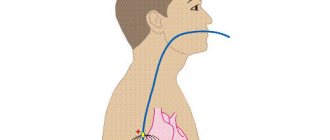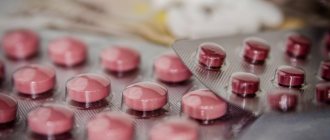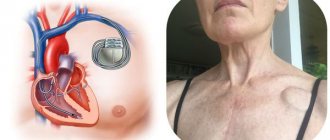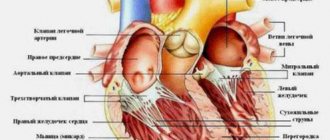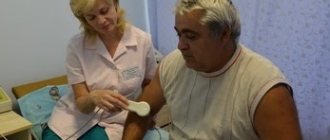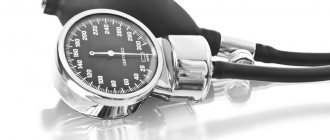In this article:
- What is pulse?
- Correct measurement algorithm
- How to measure pulse using a tonometer?
- How does a pulse oximeter work?
- Benefits of a heart rate monitor
- What can fitness bracelets do?
- Pros of using devices
- How to evaluate heart rate?
Pulse measurement is the easiest and most accessible way to assess the condition of the cardiovascular system. You can determine your indicator at home, while walking, or in any other circumstances. To calculate your heart rate manually, a regular watch with a stopwatch is sufficient, but you can also use modern gadgets that will determine and store the resulting value in memory.
How to measure pulse in the neck correctly
To correctly measure your neck pulse, it is important to consider:
- the patient's position is only sitting or lying down;
- the pressure should be light, since with strong pressure the heart rate slows down, in sensitive patients there is a risk of cardiac arrest;
- if it is necessary to determine the heart rate on both sides, you should alternately count the pulse on the right and left; while simultaneously pressing on the projection points of the carotid arteries, dizziness and lightheadedness may occur;
- before starting the stopwatch, you need to find the pulsation point with two fingers on the side of the thyroid cartilage (Adam's apple);
- repeated measurements are carried out at intervals of 5-7 minutes to restore the heart rate.
What is pulse?
First, you need to define the basic concepts, figure out what and why you will measure. Not everyone knows that heart rate and pulse are not the same thing. The first indicator reflects the number of contractions of the ventricles of the heart per minute, i.e. how many times during this period the ventricles filled with blood and pushed it into the aorta and pulmonary artery. And the pulse is the number of vibrations in the walls of the arteries that occur due to contractions of the heart.
In a healthy person, these indicators are the same, but in some pathologies they may differ. The norm for an adult is a pulse rate of 60-90 vibrations per minute; in children, the indicator is determined by age. The younger the child, the faster his pulse. When measuring the pulse, the doctor determines several parameters:
- Frequency;
- Filling;
- Voltage;
- Height;
- Rhythm;
- Form.
By taking measurements yourself, you can only find out the frequency. But this indicator also allows you to evaluate the work of the heart, choose the right physical activity, and notice changes in time.
Normal heart rate in adults and children
Heart rate can depend not only on diseases, but also on many other factors. In particular, on gender and age, body weight and temperature, diet and even the environment. For example, people who are professionally involved in sports have a faster heart rate than untrained people; The pulse quickens in the afternoon and slows down at night.
In order for anyone to determine whether their pulse is normal, they should first take into account their age.
The norm for children is:
- in newborns - from 110 to 160 beats per minute
- in infants from 1 month to 1 year – from 100 to 150
- children from 3 to 8 years old – from 70 to 125
- children from 9 to 11 years old – from 60 to 100
- teenagers from 12 to 15 years old – from 55 to 95
in adults:
- up to 50 years – from 64 to 84
- up to 60 years – from 64 to 84
- after 60 – from 69 to 89
Correct measurement algorithm
There is a simple heart rate measurement algorithm that can be used in any circumstances. The pulsation can be clearly felt on the wrist, and equally on both hands. For such a measurement, several conditions must be met:
- Place your wrist at heart level in the palm of your other hand;
- Feel the pulse on the palmar side along the edge where the thumb is located (on the side of the little finger the pulse is usually not audible, this is due to the location of the radial artery);
- Wrap your fingers around your wrist so that your index finger is closer to the wrist joint;
- Apply gentle pressure with your fingertips on the wrist in the direction of the radius.
In this case, the middle and index fingers should feel the pulse wave - rhythmic vibrations of the artery wall. It is necessary to note the time and count the number of beats per minute.
Alternatively, you can measure your pulse in your neck. To do this, you need to find the carotid artery: run your fingers from the back corner of the lower jaw down the neck. However, it is believed that determining the pulse on the hand is more comfortable, and its results are more accurate.
How to check your heart rate?
On the wrist (on the radial artery)
.
Turn your hand palm up. Place two fingers on the outside of your wrist. Feel the rush of blood under your fingertips. Take a watch or stopwatch and count the number of shocks in a minute or 30 seconds, multiplying this figure by two. On the neck (on the carotid artery)
.
Place your index and ring fingers on your neck, next to your trachea. Count the number of beats per minute. In addition, the pulse can be checked in other large vessels: - in the area of the biceps or elbow, - on the head next to the ear, - in the middle of the instep of the foot, - on the temple, - on the edges of the lower jaw, - in the groin. You can also use a heart rate monitor
. Heart rate monitors exist as independent devices, but can be included in the design of watches and even mobile phones.
How to measure pulse using a tonometer?
You can use special instruments for measurements. There are several options to check your pulse and at the same time find out some other important indicators. One of them is a tonometer. Such a device records pulse and blood pressure, and modern models are capable of:
- Save results in memory;
- Compare indicators with the norm, identify deviations;
- Calculate average values for a certain period;
- Transfer information through applications to mobile devices or to a computer, where you can conduct a full analysis, including using graphs and diagrams.
To get accurate results, you need to take measurements correctly. Measurements are taken in a sitting position, the cuff on the arm should be at the level of the heart. It is important to calm down and comply with all the requirements listed in the instructions for the device.
Automatic blood pressure monitors inflate the cuff themselves and take measurements. The user can only estimate his pulse and pressure using the numbers on the display.
Atrial fibrillation
If with respiratory arrhythmia there is some order in the heartbeats, then with atrial fibrillation they follow without any pattern at completely different intervals. This is easy to notice by the pulse, since the waves become disordered and it is absolutely impossible to determine at least some principle of change in their frequency.
Atrial fibrillation can be a manifestation of serious disturbances in the functioning of the heart. It often occurs after a myocardial infarction and persists for life.
Once you have determined the rhythm of the pulse waves (and therefore the heartbeats), you need to calculate their number per minute. To do this, you need to count the waves for a whole minute, since their frequency may change during this time, and you will get inaccurate results. It would be much more convenient and correct to count the number of waves in 10 or 15 seconds, and then multiply by 6 or 4, respectively.
A result of 60 to 80 beats per minute is considered normal. Anything above this is considered tachycardia (fast heart rate), and anything below is considered bradycardia (slow heart rate).
Tachycardia can be a sign of a large number of diseases or simply indicate a change in the functioning of the body. It occurs in healthy people in cases where tissues require more oxygen (for example, during physical activity, fear or anxiety). In addition, tachycardia always occurs when blood pressure in the vessels decreases. Increased heart rate can occur in many diseases (for example, hyperthyroidism (increased amounts of thyroid hormones in the blood), many infectious diseases, etc.).
This is interesting!
It has been established that a woman has a softer pulse than a man. Old people have an empty pulse: there is little energy in it. Children have a fast, hard, frequent pulse.
In addition, tachycardia can also occur when the normal functioning of the heart is disrupted.
Bradycardia also occurs in many diseases, including hypothyroidism (a decrease in the amount of thyroid hormones in the blood), all kinds of poisoning that affect the functioning of the heart (including poisoning with certain medications), etc.
Now determine the pulse voltage. To do this, press the artery tightly against the bone with your fingers so that the pulsation completely stops. If you succeeded with difficulty, the pulse is called hard, but if the artery is pressed lightly, the pulse is soft. In a healthy person, there is a golden mean between a hard and soft pulse.
A hard pulse occurs when blood pressure in the vessels increases: in hypertension, when the amount of thyroid hormones in the blood increases, etc. In addition, it is possible during physical or emotional stress, when the heart works harder than usual to supply organs and tissues the right amount of oxygen.
The pulse becomes soft when the blood pressure in the vessels decreases (for example, during shock), as well as in some heart diseases, when the heart contracts weaker than usual.
In addition, the pulse voltage also depends on the condition of the vessel itself, or rather, its wall. It is usually thin and smooth.
You've probably heard about atherosclerosis - a disease in which peculiar growths - plaques - appear on the walls of the arteries. As a result, the wall of such a vessel becomes denser, and its lumen narrows. If atherosclerosis has also affected the radial artery, this can be determined by the pulse. It will be hard, when you squeeze the artery so that the blood does not pass through it, you will still feel the thread of the vessel under your fingers.
The filling of the pulse depends on how much the artery fills with blood during the passage of the next wave. It depends on the level of blood pressure in the arteries, and therefore on the work of the heart, on the amount of blood in the body, etc. The normal filling of the artery is easy to determine: during the passage of the pulse wave it noticeably expands, and finding the place of pulsation is not difficult.
When blood pressure in the vessels decreases (myocardial infarction, shock or severe blood loss), the pulse becomes empty.
The pulse value is actually a combination of its two previous characteristics: tension and filling. The magnitude is the degree of expansion of the artery during the passage of the pulse wave. It depends primarily on the blood pressure in the vessels. With high blood pressure, as well as with some heart defects, the pulse becomes large and can be easily felt under the thin skin of the wrist. If the blood pressure decreases, the pulse becomes small. In this case, finding the artery is not so easy. With a serious decrease in blood pressure, the pulse becomes thread-like. In this case, the artery can barely be felt under the skin, and it seems that it is no thicker than a thread. Usually, the person turns pale, cold sweat appears on the skin, and the eyes become dark. Sometimes he may even lose consciousness. If a thread-like pulse appears, you should immediately call a doctor.
How does a pulse oximeter work?
Another modern pulse device is a pulse oximeter. Its functions are to determine saturation and count the heart rate (pulse rate). This is a medical device, before using it you need to understand the features of its use.
So, pulse oximeter – what is it and how does it work? The device is equipped with two light sources with different wavelengths and a photosensor that detects the reflection/absorption of light waves by various tissues. The light is partially reflected/absorbed when passing through soft tissues and blood, this makes it possible to determine saturation - the saturation of arterial blood with oxygen as a percentage. The normal rate varies from 95% to 100%; lower values indicate malfunctions in the functioning of the body systems.
To measure your pulse with this device, you need to attach the sensor to your fingertip, press the button and wait a few seconds. The display will show two indicators simultaneously: pulse and saturation. If the values are outside the normal range, a beep will sound.
Respiratory arrhythmia
Arrhythmia is a disturbance in the normal rhythm of the heart. Sometimes it can be related to breathing. At the same time, when a person inhales, the heart begins to beat faster, and when he exhales, it slows down.
This is interesting!
It’s still interesting how different we are from our smaller brothers! For us, respiratory, or, as it is also called, sinus arrhythmia, is a violation of the normal rhythm of the heart, but for dogs, for example, this condition is the norm.
Outwardly, respiratory arrhythmia does not manifest itself in any way, but it is not difficult to determine it by the pulse: just pay attention to the increase in the amount of will during inhalation and the decrease during exhalation.
Benefits of a heart rate monitor
Tonometers and pulse oximeters are medical devices and are convenient to use at home. But many convenient gadgets have been created for people who prefer an active lifestyle. There is even a special device for measuring pulse, which is called a pulsometer.
Basically, devices of this type look like a wristwatch and are used to assess the effectiveness of physical activity by measuring heart rate. In addition to counting your pulse, heart rate monitors perform many useful functions:
- Calculate the average heart rate;
- Determine the maximum values;
- Allows you to set up an individual training zone and notifies you when you go beyond it with an audible signal;
- Equipped with a countdown timer;
- Show date, time, day of the week;
- Works as a stopwatch and alarm clock;
- They are synchronized with special software to transfer data to a phone or computer, where the dynamics can be analyzed.
Many devices provide additional functions, for example, determining the height or number of laps while running, calculating energy consumption, recording the acceleration of the legs, and others. Some models are equipped with a chest belt. The main advantage of heart rate monitors is the most accurate pulse determination, comparable to ECG data.
Pulse zones
There are 5 pulse zones, and each subsequent one will differ in that the pulse in it is higher, respectively, in the first pulse zone the load will be minimal, and in the fifth – maximum.
Zone 1. Recovery or “therapeutic” zone.
The pulse value in this zone is 50-60% of the maximum heart rate (HR), which you can calculate using the formulas given above . The pulse value in the first zone will be approximately half of the resulting number.
Training in this range will be useful for those who have just embarked on the path to healing the body and have poor physical fitness. Loads of this intensity train the heart without unnecessary risk. Any person can carry out loads in this zone without fear for their health. It is recommended to warm up and cool down in this heart rate zone.
Zone 2. Fat burning zone.
The heart rate in this zone is 60-70% of the maximum heart rate . Suitable for anyone with frequent, low-intensity workouts. When training in this range, the fat burning mechanism is activated, and body weight loss occurs due to subcutaneous fat tissue.
In this pulse zone, overall endurance is strengthened and fat burning processes are stimulated.
There is one BUT: we remember that fat burning begins 30-40 minutes after the start of the load, so working at such a pulse should be at least 30-40 minutes. Target sensations: easy breathing, low muscle load, light sweating.
Zone 3. Strength endurance zone.
The heart rate is 70-80% of the maximum heart rate. If you fall into this zone, then the training is effective and you are improving your performance. However, staying in this zone should be short-term, because only trained people, athletes, can work for a long time at such a pulse.
This zone is best suited for increasing the body's endurance. Load duration: 10 minutes or more (depending on fitness; the more trained the body, the longer the interval of stay in this zone). It is this zone that we try to catch during maximum load in the middle of a workout, when we count the pulse.
Zone 4. Improvement zone.
The heart rate is 80-90% of the maximum heart rate. When training at this pulse, anaerobic endurance increases and the ability to achieve maximum results increases.
Load duration: 2-10 minutes. Most often, this zone is used during training by athletes or people who train for a long time.
Zone 5. Maximum heart rate zone.
Heart rate: 90-100% of maximum. This zone is rarely used, in preparation for competitions exclusively by professional athletes.
We have created a convenient tool for you to calculate your individual heart rate zones. You can print it out, enter your calculated values and use this data when planning your training process.
Optimal heart rate indicators:
- During warm-up, the heart rate should not exceed 20 beats. in 10 sec. (120 beats/min). The measurement should be taken immediately after completing a dynamic warm-up (before the inhalation-exhalation cycles). If after the warm-up your heart rate is more than 15 beats per 10 seconds (90 beats/min), then most likely the warm-up was too intense for you.
- During the main part of the workout, the heart rate should be within 27-30 beats per 10 seconds (162-180 beats/min) and not exceed this value (take measurements at the peak of the load in order to be able to adjust the load level). If you find a lower heart rate, try doing the exercise at a faster speed. If, when monitoring your heart rate during the main part of the workout, you received a value exceeding 27-30 beats per 10 seconds (170-180 beats/min), we recommend reducing the load by switching to a lighter option (if you initially performed it, reduce the pace of the exercises or increase rest intervals).
- For people who have not previously exercised, we recommend that the first 2 weeks exercise less intensely, so that the heart rate at the peak of the load does not exceed 25 beats in 10 seconds (150 beats/min). In subsequent weeks, with good load tolerance, it is possible to increase the intensity to a heart rate of 27-30 beats. in 10 sec.
- Upon completion of the cool-down and stretching (15 minutes after training), the heart rate should return to its original value - the one you measured before training. This indicates good recovery of the body and indicates a correctly selected load. At first, a rapid pulse may persist after training, which indicates that the body is poorly trained, or that the load is too high. If you train for a long time, such repeated incomplete recovery may indicate overwork. Then analyze your regime, diet, training cycle and make adjustments so that the exercises are beneficial.
In order not to harm yourself and to properly train your cardio-respiratory system, it is important to train according to pulse zones.
| Start and end the workout in the first heart rate zone (50-60% of the maximum), gradually move through the second zone to the third, bringing the heart rate to 80% of the maximum, and end the workout with a decrease in heart rate. |
Thus, the body will receive a harmonious load, and fitness will increase.
Author: Irina Yakimova, sports doctor #SEKTA, candidate of medical sciences, general practitioner
What can fitness bracelets do?
One way to check your pulse and get a lot of other useful information is to use fitness bracelets.
The compact device is fixed on the wrist according to the same principle as a watch. It doesn’t interfere with work, walking, training, and it’s even comfortable to sleep with. All this time the device measures:
- Number of steps taken and distance in km;
- Duration of sports training;
- Achievement of set goals in %;
- Volume of calories burned;
- Duration and quality of sleep.
The range of options depends on the model. For example, some devices synchronize with a smartphone, inform about incoming calls and messages, and transfer the results of all measurements to a mobile device for subsequent analysis. All fitness bracelets function as watches and alarms.
Heart rate during exercise
| Maximum heart rate is the maximum number of heartbeats per minute. This value depends on age and concomitant diseases. |
Measuring your heart rate before training should be done in a calm environment (without previous load). Excitement, laughter, other emotions, physical activity (running, jumping, fast walking), and a short period of rest after a previous workout can change normal readings. If possible, take the measurement again.
| If the pulse rate before the start of training is 10-15 beats per 10 seconds (60-90 beats/min), you can begin the volume of load that is determined for you. |
Most often, the maximum frequency (FR (max)) is calculated using the Haskell-Fox formula: FR (max) = 220 – age.
| Karvonen's formula is more accurate: HR during training = (maximum heart rate - resting heart rate) * intensity (in percent) + resting heart rate. |
None of the formulas have scientific accuracy ; however, focusing on their indicators, you can control the level of load during training.
You can use a less labor-intensive calculation: taking into account the fact that maximum performance develops when the pulse reaches 170-180 beats per minute, we will take this value as 80-90% of the emergency rate (max.) and will carry out all calculations based on it. This way we will get optimal heart rate readings during training.
During training, the heart rate increases - this is natural and absolutely normal. By monitoring our pulse and entering it into different pulse zones, we can set and control the intensity of the workout, receive important information about our condition and the ability to prevent undesirable consequences.
Pros of using devices
Such devices are very popular due to their many advantages:
- A person can always evaluate his physical activity and, if necessary, adjust it;
- Calorie counter helps you stay fit;
- Heart rate measurement is carried out in real time with high accuracy;
- The cost of the devices is quite affordable;
- The bracelets look stylish and elegant;
- The device combines many useful functions.
In addition, fitness bracelets are easy to use. With their help, it is convenient to monitor your pulse during training without being distracted by taking measurements. Just place your finger and wait a few seconds for the measurement result.
Useful tips
- It is best to lie still for one minute before taking your heart rate.
- If any degree of heart rate irregularity occurs, seek immediate medical attention.
- Do not palpate both carotid arteries at the same time, because this can reduce blood flow to the brain.
- Do not press too hard on the neck while palpating the carotid artery, as... this exposure may stimulate a reflex mechanism that will slow the heart rate.
Category:Health | Tag:health
How to evaluate heart rate?
Self-monitoring your heart is quite easy, especially with heart rate bracelets and other smart devices. But it is also important to evaluate the results correctly. To do this, you should take into account several nuances:
- The normal pulse at rest is 60-80 beats per minute;
- For women, the rate is 5-10 beats higher;
- The pulse in a lying position is minimal, in a sitting position it increases by 4-6 beats, while standing - by 10-14 beats per minute;
- In winter, the rate may be lower than in summer;
- Throughout the day, the pulse changes from the slowest at night to the maximum at 18-20 hours, increasing at 8-12 hours and about 15 hours, but it all depends on the daily routine of a particular person;
- After eating hot food and drinks, the pulse quickens.
Heart rate is related to physical activity: the more intense it is, the higher the indicator will be. During active sports, the heart rate increases to 150 beats per minute. A level of 200 blows is considered critical; at this level, the load must be reduced. In athletes, the heart muscle is more trained, so the heart rate during exercise grows more slowly than in an ordinary person.
Before checking the pulse on your hand or assessing the performance of special devices, it is worth considering the factors that influence the heart rate. The pulse increases not only due to physical activity. This effect can be caused by stressful situations, overeating or severe hunger, drinking alcohol or smoking, and even massage.
A heart rate deviation of 10% or more from normal may be a cause for concern. For example, if you have a constant rate above 90 beats per minute under the age of 30, you should consult a cardiologist. A decrease to 50 beats or below may also indicate the development of pathological processes in the body. A drop to 40-35 beats indicates a real threat to life.
Pulse measurement allows you to monitor the condition of the body, obtain objective indicators of the functioning of the heart and blood vessels, and promptly identify deviations. You can determine the indicators yourself manually or using special devices that monitor the pulse automatically with high accuracy.
If you can't measure your pulse
If the pulse on the carotid artery cannot be measured, then this is a sign of death. The patient requires urgent resuscitation measures to save his life. The assumption of cardiac arrest is confirmed by the following signs:
- pale or bluish skin,
- lack of consciousness
- cessation of breathing.
Indirect cardiac massage during cardiac arrest
In this case, it is necessary to provide first aid:
- Free your chest from clothing and loosen your belt.
- Strike the center of the sternum with your fist.
- Check the pulse in the carotid artery; if it is not there, then begin chest compressions with a frequency of 60-70 compressions per minute, the sternum should drop down 3-4 cm.
We recommend reading about what causes low heart rate and high blood pressure. From the article you will learn what is the normal pulse rate for hypertensive patients, what diseases lead to low pulse and high blood pressure, what can be done at home, and correction of the condition with medications.
And here is more information about what your heart rate should be to burn fat.
You can measure the pulse on the radial and carotid arteries by counting beats in 1 minute. The most accurate method, especially for arrhythmia, is an ECG; a tonometer, pulse oximeter, and fitness bracelet can help in determining heart rate.
How to measure blood pressure correctly
According to statistics, about 40 percent of the adult population of Russia suffer from high blood pressure. Among people over 65 years of age, this figure is even higher and is more than 55%. Research shows that the disease, hypertension, is getting younger and is now being diagnosed in teenagers.
The insidiousness of this disease is that at first it often does not affect one’s well-being in any way - it is not without reason that hypertension is called the “silent killer”.
The patient has no complaints, and if it is possible to accidentally detect an increase in blood pressure, he does not attach serious importance to it - “I don’t have any pain, I feel great.” And he does nothing. And hypertension increases, undermines the condition of blood vessels and then the health of other so-called target organs (heart, kidneys, retina, brain). After some time, the state of health actually worsens, and complaints appear - but the disease has already gone too far, and its development could have been restrained by regular medication.
A prolonged increase in blood pressure without appropriate ongoing therapy leads to heart and kidney failure, serious visual impairment, heart attacks and strokes.
In the case of hypertension, more than with any other disease, collaboration between doctor and patient is extremely important. The patient’s compliance, that is, his willingness to strictly follow the doctor’s requirements, recommendations and prescriptions, is half the success in curbing the progression of this dangerous pathology. At the same time, a significant proportion of people with hypertension not only do not receive any treatment because they do not go to the doctor - they do not even know how to measure their blood pressure.
A threat to health and, at the same time, an asymptomatic course - this is the answer to the question of why measure blood pressure. Periodic monitoring of blood pressure is necessary for all people over 35 years of age. Blood pressure is very unstable: its level changes many times during the day, in addition, it can be influenced by a huge number of factors.
How to measure blood pressure correctly? What should be the measurement procedure for the readings to be correct? Here are some rules:
- Take the measurement in a calm environment, not while running. Before the procedure, you need to sit quietly for about five minutes.
- Ideally, take the measurement on an empty stomach, or in extreme cases, no earlier than two hours after eating.
- To perform the procedure, sit at a table, the tonometer (if it has a shoulder cuff) should be on the table, the distance between the seat and the surface of the table should be about 25-30 cm (this means that measuring the pressure at a coffee table, sitting sideways, in a chair, pointless). The back should be straight, supported by the back of the chair. If you are using the wrist version of a digital blood pressure monitor, you can take measurements off the table, but your wrist should be at heart level. Please note: a wrist tonometer is not a good option for older patients; they are better off using a device with a brachial cuff.
- During the measurement, you cannot move or talk - this will affect the readings.
- Sometimes it is recommended to take two or three measurements - if on one hand, then with a break of 7-10 minutes, if on different ones, 2 minutes is enough.
- On which hand to measure the pressure: during the first measurement, you need to take readings on both hands. In the future, continue to measure the pressure on the arm where the readings were higher. The difference in numbers on different hands is normal; on the “leading” hand the pressure will be slightly higher.
Important:
- The readings may be affected by stress suffered the day before, drinking coffee, alcoholic or tonic drinks, or smoking.
- If you keep a diary of self-monitoring of blood pressure, measure your blood pressure twice a day at the same time. Ideally, 20 minutes after waking up and before going to bed.
If your blood pressure does not exceed 140/90 (in patients with diabetes, the limit should be 130/80), there is no reason to worry - your blood pressure is within the normal range.
If hypertension is detected for the first time or if the patient is being selected for medications for hypertension and their dosages, the cardiologist may refer the patient for daily blood pressure monitoring. During the day, a special device attached to the patient’s body will measure pressure: every 15 minutes during the day, every half hour at night. The patient will be required to keep a diary of his activity on this day and record what he was doing at one time or another in order to compare his actions with the readings of the device. Based on the indications, conclusions are drawn about the correctness of therapy, and adjustments are made to the patient’s daily routine. Daily blood pressure monitoring may also be required for a pregnant patient with high blood pressure, and is prescribed to representatives of certain professions associated with risk.
Convenient contact with a medical center in Rostov-on-Don is all forms of service provision. At the Heratsi Clinic, where experienced therapists and cardiologists work, who will help you clearly and correctly carry out diagnostic measures and develop an effective treatment plan, you can get advice both in the clinic and at home or online.
The center periodically offers promotions, discounts, and medical services on special terms.
Make an appointment with a cardiologist (Rostov-on-Don) by calling the 24-hour hotline +7. The cost of medical center services can be found by phone or in the “Price” section.


